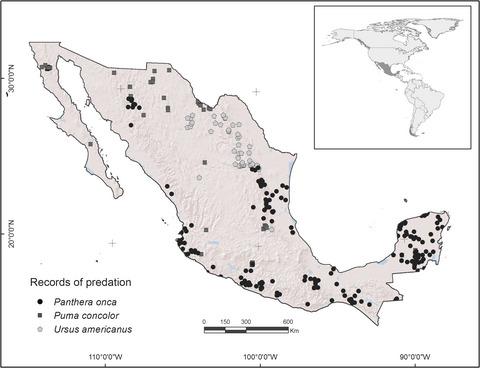当前位置:
X-MOL 学术
›
Anim. Conserv.
›
论文详情
Our official English website, www.x-mol.net, welcomes your
feedback! (Note: you will need to create a separate account there.)
Regionalization of environmental and anthropic variables associated to livestock predation by large carnivores in Mexico
Animal Conservation ( IF 2.8 ) Pub Date : 2019-07-20 , DOI: 10.1111/acv.12527 F. Reyna‐Sáenz 1 , M. M. Zarco‐González 1 , O. Monroy‐Vilchis 1 , X. Antonio‐Némiga 2
Animal Conservation ( IF 2.8 ) Pub Date : 2019-07-20 , DOI: 10.1111/acv.12527 F. Reyna‐Sáenz 1 , M. M. Zarco‐González 1 , O. Monroy‐Vilchis 1 , X. Antonio‐Némiga 2
Affiliation

|
Conflicts with humans are one of the main causes of the decline in populations of large carnivores, making it a crucial conservation issue worldwide. In Mexico, jaguar Panthera onca, puma Puma concolor and American black bear Ursus americanus are involved in livestock predation and are persecuted in retaliation. The sites where predation occurs are distributed throughout the country and differ not only in environmental characteristics, but also in social, economic and livestock management practices. However, due to the general focus of the studies carried out so far, the proposed mitigation measures are also general. It is necessary to consider conditions that encourage predation in the design of strategies to be more effective. In this study, environmental, anthropic and livestock management characteristics of livestock predation by large carnivores were analyzed for conflict regionalization. The variables most related to predation sites were identified, with a high percentage of them being livestock management practices. Based on these variables, we formed clusters of similar sites and analyzed their spatial distribution, which presented grouping patterns in the cases of predation by puma and black bear, in contrast to the jaguar clusters, which presented a dispersed distribution. Considering the characteristics of the clusters, we propose as mitigation measures the confinement of livestock, construction or improvement of corrals and improvement of management practices. The anthropic component and livestock management practices are closely related to the predation events and, therefore, their inclusion in the conservation programs of carnivores in Mexico is fundamental.
中文翻译:

墨西哥大型食肉动物与家畜捕食相关的环境和人类变量的区域化
与人类的冲突是大型食肉动物种群减少的主要原因之一,这使其成为全球至关重要的保护问题。在墨西哥,美洲虎Panthera onca,美洲狮美洲豹和美洲黑熊Ursus americanus参与捕食牲畜并受到报复的迫害。发生捕食的地点分布在全国各地,不仅环境特征不同,而且在社会,经济和牲畜管理方面也不同。但是,由于到目前为止已进行了广泛的研究,因此拟议的缓解措施也是一般性的。有必要考虑在战略设计中鼓励掠夺的条件更加有效。在这项研究中,分析了大型食肉动物捕食牲畜的环境,人类和牲畜管理特征,以进行冲突区域化。确定了与捕食场所最相关的变量,其中很大一部分是牲畜管理实践。基于这些变量,我们形成了相似地点的簇,并分析了它们的空间分布,在美洲狮和黑熊被捕食的情况下,它们表现出分组模式,而美洲狮簇则呈现出分散的分布。考虑到这些集群的特征,我们提出了限制牲畜,建造或改善畜栏以及改善管理措施的缓解措施。人为因素和牲畜管理做法与捕食事件密切相关,因此,将其纳入墨西哥食肉动物的保护计划至关重要。考虑到这些集群的特征,我们提出了限制牲畜,建造或改善畜栏以及改善管理措施的缓解措施。人为因素和牲畜管理做法与捕食事件密切相关,因此,将其纳入墨西哥食肉动物的保护计划至关重要。考虑到这些集群的特征,我们提出了限制牲畜,建造或改善畜栏以及改善管理措施的缓解措施。人为因素和牲畜管理做法与捕食事件密切相关,因此,将其纳入墨西哥食肉动物的保护计划至关重要。
更新日期:2019-07-20
中文翻译:

墨西哥大型食肉动物与家畜捕食相关的环境和人类变量的区域化
与人类的冲突是大型食肉动物种群减少的主要原因之一,这使其成为全球至关重要的保护问题。在墨西哥,美洲虎Panthera onca,美洲狮美洲豹和美洲黑熊Ursus americanus参与捕食牲畜并受到报复的迫害。发生捕食的地点分布在全国各地,不仅环境特征不同,而且在社会,经济和牲畜管理方面也不同。但是,由于到目前为止已进行了广泛的研究,因此拟议的缓解措施也是一般性的。有必要考虑在战略设计中鼓励掠夺的条件更加有效。在这项研究中,分析了大型食肉动物捕食牲畜的环境,人类和牲畜管理特征,以进行冲突区域化。确定了与捕食场所最相关的变量,其中很大一部分是牲畜管理实践。基于这些变量,我们形成了相似地点的簇,并分析了它们的空间分布,在美洲狮和黑熊被捕食的情况下,它们表现出分组模式,而美洲狮簇则呈现出分散的分布。考虑到这些集群的特征,我们提出了限制牲畜,建造或改善畜栏以及改善管理措施的缓解措施。人为因素和牲畜管理做法与捕食事件密切相关,因此,将其纳入墨西哥食肉动物的保护计划至关重要。考虑到这些集群的特征,我们提出了限制牲畜,建造或改善畜栏以及改善管理措施的缓解措施。人为因素和牲畜管理做法与捕食事件密切相关,因此,将其纳入墨西哥食肉动物的保护计划至关重要。考虑到这些集群的特征,我们提出了限制牲畜,建造或改善畜栏以及改善管理措施的缓解措施。人为因素和牲畜管理做法与捕食事件密切相关,因此,将其纳入墨西哥食肉动物的保护计划至关重要。











































 京公网安备 11010802027423号
京公网安备 11010802027423号